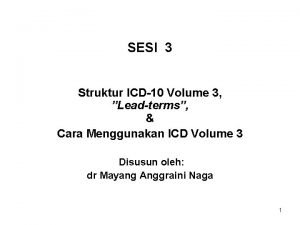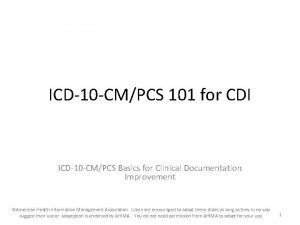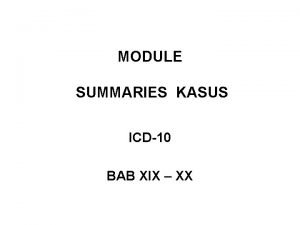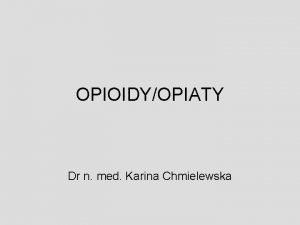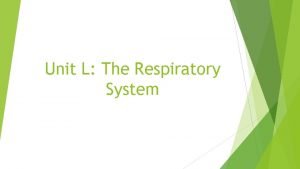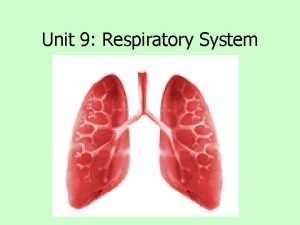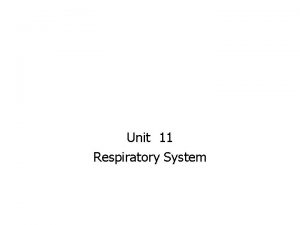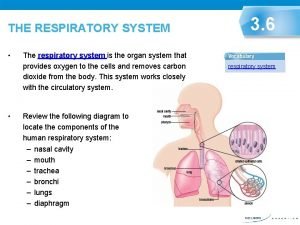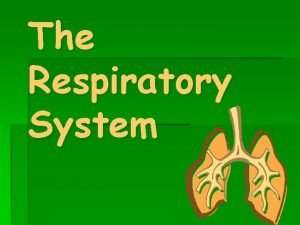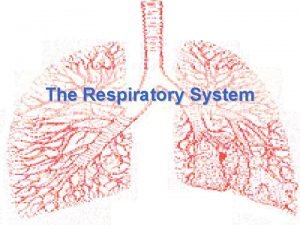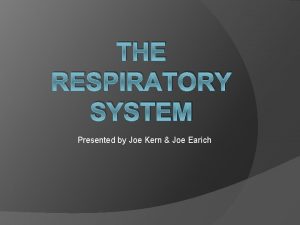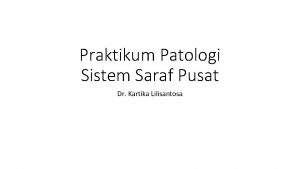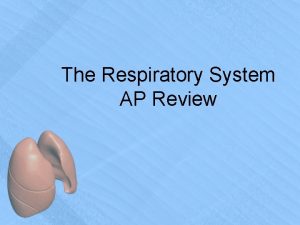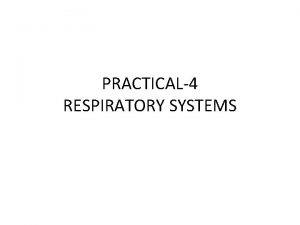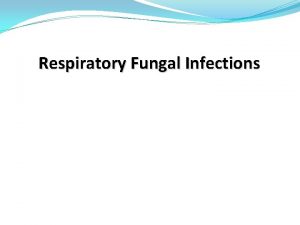RESPIRATORY SYstem Dr KARTIKA LILISANTOSA ICD10 A 15






![J 00 -J 06 Acute upper respiratory infections J 00 Acute nasopharyngitis [common cold] J 00 -J 06 Acute upper respiratory infections J 00 Acute nasopharyngitis [common cold]](https://slidetodoc.com/presentation_image_h2/8456b90b283432b85e726022eaaceeee/image-7.jpg)
![J 00 Acute nasopharyngitis [common cold] = mild upper respiratory viral illness except influenza J 00 Acute nasopharyngitis [common cold] = mild upper respiratory viral illness except influenza](https://slidetodoc.com/presentation_image_h2/8456b90b283432b85e726022eaaceeee/image-8.jpg)
![J 00 Acute nasopharyngitis [common cold] The diagnosis is based on symptoms and observed J 00 Acute nasopharyngitis [common cold] The diagnosis is based on symptoms and observed](https://slidetodoc.com/presentation_image_h2/8456b90b283432b85e726022eaaceeee/image-9.jpg)


![J 05 Acute obstructive laryngitis [croup] and epiglottitis = laryngotracheobronchitis Usually caused by virus J 05 Acute obstructive laryngitis [croup] and epiglottitis = laryngotracheobronchitis Usually caused by virus](https://slidetodoc.com/presentation_image_h2/8456b90b283432b85e726022eaaceeee/image-12.jpg)












- Slides: 24

RESPIRATORY SYstem Dr. KARTIKA LILISANTOSA

ICD-10 A 15 Respiratory Tuberculosis J 00 -J 99 Diseases of the respiratory system J 00 -J 06 Acute upper respiratory infections J 09 -J 18 Influenza and pneumonia J 20 -j 22 Other acute lower respiratory infections J 30 -J 39 Other diseases of upper respiratory tract J 40 -J 47 Chronic lower respiratory diseases J 60 -J 70 Lung diseases due to external agents J 80 -J 84 Other respiratory diseases principally affecting the interstitium J 85 -J 86 Suppurative and necrotic conditions of the lower respiratory tract J 90 -J 94 Other diseases of the pleura J 95 Intraoperative and postprocedural complications and disorders of respiratory system, not elsewhere classified J 96 -J 99 Other diseases of the respiratory system

A 15 Respratory Tuberculosis A 15. 0 Tuberculosis of lung A 15. 4 Tuberculosis of intrathoracic lymph nodes A 15. 5 Tuberculosis of larynx, trachea and bronchus A 15. 6 Tuberculous pleurisy A 15. 7 Primary respiratory tuberculosis A 15. 8 Other respiratory tuberculosis A 15. 9 Respiratory tuberculosis unspecified

Tuberculosis Infectious disease by Mycobacterium tuberculosis Infected Lung but can also affect the lungs

Mycobacterium tuberculosis M. tuberculosis is a bacillus has an unusual, waxy coating on its cell surface primarily due to the presence of mycolic acid. This coating makes the cells Acid-fast stains such as Ziehl-Neelsen The physiology of M. tuberculosis is highly aerobic and requires high levels of oxygen M. tuberculosis is characterized in tissue by caseating granulomas containing Langhans giant cells

RESPIRATORY TUBERCULOSIS Spread through air from active TB (when the patient cough, spit, speak, or sneeze) Symptoms : Chronic cough with blood containing sputum (hemoptysis) Fever Night sweats Weight loss Diagnostic: Chest X-ray Microscopic examination and culture of body fluids (sputum BTA 3 x) Tuberculin skin test Interferon gamma release assays (IGRA)
![J 00 J 06 Acute upper respiratory infections J 00 Acute nasopharyngitis common cold J 00 -J 06 Acute upper respiratory infections J 00 Acute nasopharyngitis [common cold]](https://slidetodoc.com/presentation_image_h2/8456b90b283432b85e726022eaaceeee/image-7.jpg)
J 00 -J 06 Acute upper respiratory infections J 00 Acute nasopharyngitis [common cold] J 01 Acute sinusitis J 02 Acute pharyngitis J 03 Acute tonsillitis J 04 Acute laryngitis and tracheitis J 05 Acute obstructive laryngitis [croup] and epiglottitis J 06 Acute upper respiratory infections of multiple and unspecified sites
![J 00 Acute nasopharyngitis common cold mild upper respiratory viral illness except influenza J 00 Acute nasopharyngitis [common cold] = mild upper respiratory viral illness except influenza](https://slidetodoc.com/presentation_image_h2/8456b90b283432b85e726022eaaceeee/image-8.jpg)
J 00 Acute nasopharyngitis [common cold] = mild upper respiratory viral illness except influenza Common cold viruses can be spread by three mechanisms: Direct contact –via hands. o Indirect contact – viruses may survive on surfaces such as countertops for several hours thus can be transmitted from touching that surface and then touching the mouth, nose, or eyes. o Inhaling viral particles. Persons with colds shed viruses the most on the second day of illness, however, low levels of viral shedding may persist for up to two weeks.
![J 00 Acute nasopharyngitis common cold The diagnosis is based on symptoms and observed J 00 Acute nasopharyngitis [common cold] The diagnosis is based on symptoms and observed](https://slidetodoc.com/presentation_image_h2/8456b90b283432b85e726022eaaceeee/image-9.jpg)
J 00 Acute nasopharyngitis [common cold] The diagnosis is based on symptoms and observed signs. Swelling and congestion of nasal passages Redness of the throat Enlarged lymph nodes in the neck Normal lung exam Symptomatic therapy is the only thing necessary for treating the common cold as it is a self-limited infection (meaning it will go away with time). Antibiotics are not effective

J 09 -J 11 INFLUENZA is an infectious disease caused by an influenza virus Type A, Type B, and Type C (family Orthomyxoviridae) The most common symptoms include: a high fever, runny nose, sore throat, muscle pains, headache, coughing, and feeling tired. These symptoms typically begin two days after exposure to the virus and most last less than a week. The cough, however, may last for more than two weeks. Complications of influenza may include viral pneumonia, secondary bacterial pneumonia, sinus infections, and worsening of previous health problems such as asthma or heart failure A vaccine made for one year may not be useful in the following year, since the virus evolves rapidly

• In highly virulent strains, such as H 5 N 1, the hemagglutinin can be cleaved by a wide variety of proteases, allowing the virus to spread throughout the body • influenza does cause tissue damage (H 5 N 1 strain causes severe viral pneumonia in the lugs) • The two classes of antiviral drugs used against influenza are neuraminidase inhibitors (oseltamivir and zanamivir) and M 2 protein inhibitors (adamantane derivatives).
![J 05 Acute obstructive laryngitis croup and epiglottitis laryngotracheobronchitis Usually caused by virus J 05 Acute obstructive laryngitis [croup] and epiglottitis = laryngotracheobronchitis Usually caused by virus](https://slidetodoc.com/presentation_image_h2/8456b90b283432b85e726022eaaceeee/image-12.jpg)
J 05 Acute obstructive laryngitis [croup] and epiglottitis = laryngotracheobronchitis Usually caused by virus parainfluenza and influenza, rarely by bacterial infection like diphtheriae The infection leads to swelling inside the trachea, which interferes with normal breathing and produces the classic symptoms of "barking" cough, stridor, and a hoarse voice narrowing of the trachea, called the steeple sign, because of the subglottic stenosis, which resembles a steeple in shape. The steeple sign is suggestive of the diagnosis, but is absent in half of cases Steroids are given routinely, with epinephrine used in severe cases. [3] Children with oxygen saturations under 92% should receive oxygen, [4] and those with severe croup may be hospitalized for observation.

J 12 -18 Pneumonia = IS AN INFLAMMATORY IN THE LUNG AFFECTING ALVEOLI CAUSED BY BACTERIA, VIRUS, FUNGI symptoms : productive or dry cough, chest pain, fever, and shortness of breath, sharp or stabbing chest pain during deep breaths, and an increased rate of breathing Diagnosis is often based on the symptoms and physical examination. [7] Chest X-ray, blood tests, and culture of the sputum

J 20 -J 22 OTHER ACUTE LOWER RESPIRATORYINFECTIONS J 20 Acute bronchitis J 21 Acute bronchiolitis J 22 Unspecified acute lower respiratory infection

J 20 Acute bronchitis = short-term inflammation of the bronchi (large and medium-sized airways) 90% caused by virus, small number by bacteria (Mycoplasma pneumoniae, Chlamydophila pneumoniae, Bordetella pertussis, Streptococcus pneumoniae, and Haemophilus influenzae) Symptoms : cough with mucus, wheezing, shortness of breath (dyspnea), fever, and chest discomfort Diagnosis : symptoms and chest x-ray , sputum and blood test

J 21 Acute bronchiolitis Bronchiolitis is blockage of the small airway in the lungs due to a viral infection (rhinovirus) usually only occurs in children less than two years of age Symptoms may include fever, cough, runny nose, wheezing, and breathing problems, nasal flaring, and or the skin between the ribs pulling in with breathing Diagnosis based on symptoms, chest x ray The risk of death among those who are admitted to hospital is about 1%.

J 40 -J 47 CHRONIC LOWER RESPIRATORY DISEASES J 40 Bronchitis, not specified as acute or chronic J 41 Simple and mucopurulent chronic bronchitis J 42 Unspecified chronic bronchitis J 43 Emphysema J 44 Other chronic obstructive pulmonary disease J 45 Asthma J 47 Bronchiectasis

Chronic Obstructive Pulmonary Disease (COPD) Occurs when the airways become inflamed and the air sacs in your ungs are damaged 1. Chronic bronchitis 2. Emphysema

J 40 -42 Chronic Bronchitis a chronic cough and sputum production for at least 3 months a year for 2 consecutive years is caused by overproduction and hypersecretion of mucus by goblet cells, increasing airflow obstruction. can be due to smoke inhalation, a viral or bacterial infection

CHRONIC BRONCHITIS Mucus metaplasia causes airflow obstruction ->it causes luminal occlusion; the thickening of the epithelial layer intrudes on the airway lumen, and the mucus alters the airway surface tension -> the airway at a greater risk for collapsing and decreases the capacity for airflow and gas exchange Diagnostic: Chest x ray, spirometry test (lung finction test), sputum, CT scan thorax

J 43 Emphysema Any abnormal accumulation of air or other gas WITHIN TISSUE Pulmonary interstitial emphysema, air trapped in the stroma (interstitium) of the lung Subcutaneous emphysema, gas or air trapped in the subcutaneous layer (that is, under the skin) PULMONARY EMPHYSEMA CAUSED BY SMOKING, EXPOSURE POLLUTION, GENETICS (ALPHA 1 ANTITRYPSIN DEFICIENCY) The most common symptoms of COPD are sputum production, shortness of breath (DYSPNEA), and a productive cough Advanced COPD leads to high pressure on the lung arteries, which strains the right ventricle of the heart. [5][24][25] This situation is referred to as cor pulmonale, and leads to symptoms of leg swelling[15] and bulging neck veins

J 45 Asthma reversible airflow obstruction, and bronchospasm Symptoms include episodes of wheezing, coughing, chest tightness, and shortness of breath caused by a combination of genetic and environmental factors. [4] Environmental factors include exposure to air pollution and allergens. Other potential triggers include medications such as aspirin and beta blockers Diagnostic : pattern of symptoms, spirometry A triad of atopic eczema, allergic rhinitis and asthma is called atopy

J 47 Bronchiectasis is an abnormal, chronic enlargement of the bronchi, the pas - sageways from the trachea to the alveoli that are the air-exchanging parts of the lungs Failure to clear secretions allows microbes and particles to collect in them, which leads to more secretions and inflammation that further damage the airways, causing more dilation in a vicious cycle Can be Localized diffuse

THANK U
 Kartika damayanti
Kartika damayanti Respiratory zone
Respiratory zone Digestive respiratory and circulatory system
Digestive respiratory and circulatory system Kode icd 10 tersiram air panas
Kode icd 10 tersiram air panas Tuli icd 10
Tuli icd 10 Icd luka bakar
Icd luka bakar Isi volume 3 icd-10 adalah
Isi volume 3 icd-10 adalah Icd10 orthopaedics
Icd10 orthopaedics Cdi icd 10
Cdi icd 10 Icd 10 code for allergic conjunctivitis
Icd 10 code for allergic conjunctivitis Icd10 sungsang
Icd10 sungsang Isrr icd 10
Isrr icd 10 Barbara kahn md
Barbara kahn md Armd icd 10
Armd icd 10 Opioidy
Opioidy How respiratory system work with circulatory system
How respiratory system work with circulatory system Circulatory system and respiratory system work together
Circulatory system and respiratory system work together Bozeman respiratory system
Bozeman respiratory system Unit 9 respiratory system
Unit 9 respiratory system Diagnostic test of respiratory system
Diagnostic test of respiratory system Respiratory system
Respiratory system The part of the respiratory system that is the voicebox
The part of the respiratory system that is the voicebox Respiratory system coloring page
Respiratory system coloring page Respiratory system purpose
Respiratory system purpose Conclusion for respiratory system
Conclusion for respiratory system






